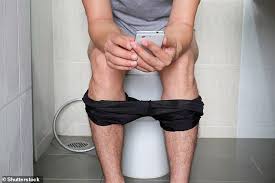Your Phone Could Be a Breeding Ground for Dangerous Bacteria – Here’s Why You Should Keep It Out of the Bathroom
Taking your phone to the toilet might seem harmless or even entertaining, but scientific research shows it could be putting your health at serious risk.
According to Professor Primrose Freestone, a clinical microbiologist at the University of Leicester, flushing the toilet releases a burst of tiny liquid droplets called a “toilet plume.” These droplets, which are invisible to the naked eye, can contain bacteria and fecal matter. Alarmingly, they can travel up to five feet in just eight seconds – and this happens even when the toilet lid is closed.
This means that any object within five feet of the toilet, including your phone, can become contaminated. Even if you don’t use your phone in the bathroom, simply bringing it into the space exposes it to harmful germs like E. coli, which can cause diarrhea and stomach cramps, and Pseudomonas, which may lead to infections in the blood and lungs.
What’s more, these bacteria can transfer back to your hands after you wash them, simply by touching your contaminated phone again. And once on your hands, they can find their way into your mouth, eyes, or onto surfaces you and others regularly touch.
Professor Freestone explains that many surfaces in bathrooms – from door handles and soap dispensers to toilet seats and bath mats – are already contaminated. Phones only add to this microbial mix, making them one of the least cleaned and most handled objects we carry.
To reduce your risk of illness, experts recommend keeping your phone out of the bathroom entirely. If you must bring it in, make sure to disinfect it regularly using alcohol-based wipes. Even Professor Freestone admits she wipes her own phone twice a week to stay safe.
Your phone may be part of your daily routine, but bringing it into the toilet might be doing more harm than you realize. Protect your health by breaking this habit and keeping harmful microbes where they belong – far away from your hands and face.
It’s a common habit, but a scientist reveals why you should never use your phone on the toilet – or even take it into the bathroom at all.
When we flush a toilet, a plume of tiny liquid droplets containing bacteria and fecal matter, invisible to the naked eye, is violently ejected.
According to prior research at the University of Colorado Boulder, this so-called ‘toilet plume’ can travel 5 feet (1.5 metres) in eight seconds.
Therefore, anything that is within five feet of the toilet bowl can become contaminated, whether it’s the floor, the wall or a nearby book.
Research also suggests that this dreaded plume still escapes when we’ve got the toilet lid closed.
As a result, Freestone urges people to keep their phone well away from the toilet, or even better, out of the bathroom entirely.
“Toilet areas adjacent to toilets, because of the toilet spray trajectory, are pretty contaminated,” she said.
“It does not matter where you go, there will be faecal bacteria on lots of [bathroom] surfaces.
“So soaps and taps, toilet and wash basin surfaces, door handles, bath mats – the list is long.”
E. coli is a harmful bacteria released from the body through feces, and it can easily spread around your home if hygiene isn’t properly maintained. Once it contaminates surfaces like hands, phones, door handles, or bathroom fixtures, it can enter the body and cause severe stomach cramps, diarrhea, and other digestive issues. To put its size into perspective, this microscopic organism is so tiny that a single micrometre — one millionth of a metre — is enough to measure it.
Each time a toilet is flushed, it releases a burst of microscopic droplets containing bacteria and fecal matter into the air — a phenomenon known as a toilet plume. In previous studies, scientists used laser technology to visually capture this invisible spray, revealing just how far and fast these potentially harmful particles can travel.
Research shows that toilet plumes — bursts of bacteria-filled droplets — still escape even when the lid is closed. Placing your phone on the bathroom floor before flushing? One of the worst moves.
According to microbiologist Professor Freestone, fecal particles settle on floors and nearby surfaces like cisterns and windowsills, staying alive for hours or even days. Your phone can easily pick up these germs.
If you absolutely must take your phone into the bathroom, keep it in your pocket — not on any surface. Better still, leave it outside. Your gut will thank you.
Keeping your phone completely out of the bathroom is one of the most effective ways to avoid exposing it to harmful toilet-borne bacteria, experts warn.
Although it may not cross our minds, phones are high-touch items that easily collect germs, much like doorknobs, light switches, and taps. That is why regular handwashing before and after using your phone, along with routine cleaning of the device, is essential.
Experts recommend sanitizing your phone with a seventy percent alcohol wipe or a mild soap and water solution. However, avoid soaking the device if it is not waterproof and steer clear of harsh cleaning agents like bleach.
In addition to phone hygiene, specialists in home sanitation also emphasize the importance of bathroom cleanliness. For instance, how you position your toilet paper matters. The “over” position, where the next sheet faces the user, is considered more hygienic compared to the “under” position that presses the paper against the wall — a surface likely to harbor bacteria.
Another major concern is what happens when you flush. A 2021 study revealed that flushing a toilet launches tens of thousands of tiny droplets into the air. These droplets, which can contain urine, feces, vomit, and viruses, were observed hovering up to five feet in the air for more than twenty seconds.
Because they are so light, these particles can float at mouth-level and drift across the room on small air currents before settling on nearby surfaces — or being inhaled. Researchers warn that these aerosols can carry infectious diseases. In fact, live coronavirus has been detected in human feces, raising concerns that flush-propelled particles from an infected person could become airborne and infect others nearby.
The takeaway is clear: practice good hygiene, clean your phone often, close the toilet lid before flushing, and, when possible, keep your phone and other items out of the bathroom entirely.




No comment